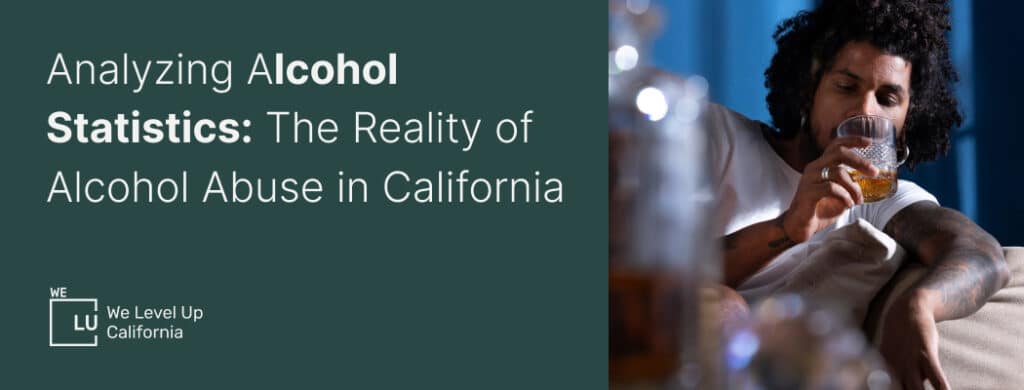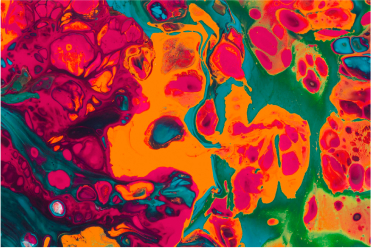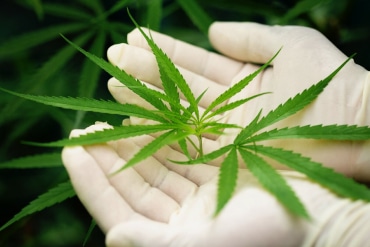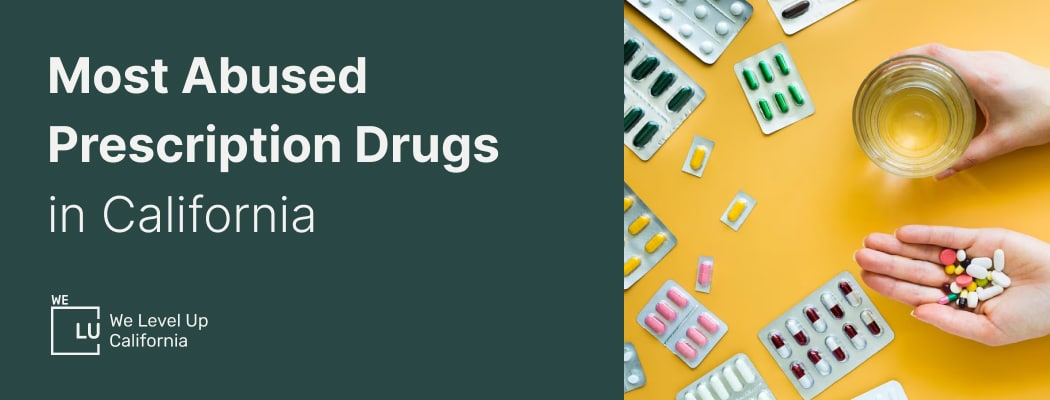Addressing alcoholism and alcohol-related issues demands a thoughtful and professional approach. It also includes a deep analysis of alcohol statistics. With this article, we intend to provide a comprehensive insight into alcohol abuse statistics, with a particular focus on the state of California. Together, we’ll explore the impact of this health concern on the region, shedding light on the broader picture. As we wrap up, we will also spotlight how We Level Up California addresses alcohol abuse in the Golden State.
Skip to:
Alcohol abuse statistics in California
According to the state government statistics for the 2020-2021 period, in California, 19,335 individuals died from excessive alcohol use, which resulted in 492,097 years of potential life lost each year. These deaths – which mostly affected males (69.5%) – shortened the lives of the individuals in question by an average of about 25 years. Chronic conditions in those addicted to alcohol, including cancer and heart disease, were responsible for 62.1% of fatalities. Meanwhile, acute causes such as injuries, violence, and vehicle crashes were behind 37.9% of alcohol-abuse-related deaths.
Diving deeper into numbers, this time those published by the National Center for Drug Abuse Statistics, we can conclude that there’s an average of 15,443 annual deaths from heavy drinking.

Here are some additional alcohol abuse statistics in California that might interest you:
- Alcohol abuse results in 5.04 deaths per 10,000 California adults.
- Adults aged 35 and older account for 86.1% of alcohol-abuse-related deaths in the Golden State.
- Underage drinking is relatively uncommon in California.
- About 16.6% of adults (18 and above) in California practice monthly binge drinking. The median number of drinks per binge is 5.5, going as far as up to 7.7 for the top 25% of adult drinkers.
- In 2010, California taxpayers spent around $35,011 billion on unrestrained alcohol use, which, adjusted for inflation, today equals $47,264 billion or $3.29 per drink.
Alcoholism statistics nationwide vs. in California
One might wonder whether alcohol abuse statistics in California differ from the rest of the US. Let’s uncover that!
In 2021, California led the way in the amount of drinks consumed, with its residents having drunk approximately 88,586 gallons of pure alcohol (ethanol). Second place went to Texas, with a total consumption of 58,893 gallons. To put it in perspective, California’s northern neighbor, Oregon, has a total ethanol consumption of about 10,110 gallons. However, one shouldn’t be too quick to judge: California is the most populous US state (with 10 times more residents than Oregon).
Once you examine nationwide alcoholism statistics by age group, California’s ranking varies. For people aged 12 and older, the Golden State falls into the second-highest tier for rates of substance use disorder involving alcohol. Notably, the most substantial rise in alcohol-related issues both nationwide and in California occurs among people aged 65 and older, with California surpassing the overall US rate by 1.3 percentage points.
Get Help. Get Better. Get Your Life Back.
Searching for an Accredited Drug and Alcohol Rehab Centers in Near You?
Even if you have failed previously and relapsed, or are in the middle of a difficult crisis, we stand ready to support you. Our trusted behavioral health specialists will not give up on you. When you feel ready or just want someone to speak to about therapy alternatives to change your life call us. Even if we cannot assist you, we will lead you to wherever you can get support. There is no obligation. Call our hotline today.
FREE Addiction Hotline – Call 24/7How alcohol statistics contribute to addiction, overall health & relationships
Not only does alcohol abuse affect the individual’s health, but it also exerts a significant influence on the community as a whole. Here, we’ll explore both the individual and societal dimensions of alcohol abuse and addiction that may stem from the terrifying consumption of alcohol statistics.
How alcohol addiction affects health
We can categorize the health risks associated with excessive alcohol consumption into two distinct groups:
- Short-term health risks.
- Long-term health risks.
When addressing the short-term risks of excessive alcohol use, we can point out a couple of issues, including injuries resulting from vehicle crashes and falls, violent behavior such as homicide or sexual assault, blood poisoning, and engaging in unsafe sexual practices that may lead to unintended pregnancies or STDs. Speaking of pregnancy, women who consume alcohol while carrying a child risk miscarriage, stillbirth, or the development of fetal alcohol spectrum disorders (FASDs).
Also, did you know that alcohol is inherently a toxin: it causes cell damage throughout the human body upon consumption. This is a well-known fact within the healthcare and scientific communities. However, it appears that this topic is not widely discussed. Many alcohol abuse awareness campaigns omit the mention of the toxic nature of ethanol.
What about the long-term risks of alcohol consumption? Unrestrained alcohol use comes with a solid amount of long-term health risks. Individuals with alcohol use disorder are at significant risk of developing chronic diseases and serious conditions, including high blood pressure, heart disease, cancer, learning problems, mental health issues, and social challenges.

Get Your Life Back
Find Hope & Recovery. Get Safe Comfortable Detox, Addiction Rehab & Dual Diagnosis High-Quality Care.
Hotline (855) 695-1160Statistics on alcohol abuse and its effects on relationships
Now that we’ve seen how alcohol addiction can ruin your health, let’s talk about its effect on the relationships you have with others.
It’s a well-known fact that excessive drinking leads to various relationship issues (estranged marriages, lost friendships, and so on). Alcohol addiction can rupture bonds and hurt the closeness and intimacy people share. Also, people who drink to excess will sometimes prioritize drinking over spending quality time with their loved ones. This will cause many relationships to crack.
Statistics on alcoholism show kids who have parents with substance abuse problems often deal with loneliness, guilt, anxiety, anger, or trust issues. On a global scale, alcohol is associated with crimes and various forms of domestic violence. About 10% of children in the US live with a parent who has alcohol issues. Further examination has shown that excessive alcohol intake leads to higher chances of violent impulse crimes in a community, and, unfortunately, kids aren’t unaware of this.
Finally, alcohol consumption disorder can alter an individual’s personality to the point of it being unrecognizable to the other person in the relationship. Alcoholism usually comes with trust issues as addicts tend to fabricate stories about where they were and what they’ve done.
Treatment and statistics on alcoholism recovery rates
Many people don’t know that alcoholism is considered a highly treatable disease, and there are alcohol facts and statistics that prove this:
- About 89% of patients who complete alcohol treatment remain clean and sober within the first month post-rehab.
- Patients who complete alcohol treatment report a general improvement in their quality of life.
- Detoxification is usually the initial stage of treatment: it helps people safely cease consumption.
- Even though it varies, the success rate for total recovery lies around 40-60%.

Alcohol detox and inpatient alcohol rehab
When a person is trying to withdraw from alcohol, being inside an institution that specializes in alcohol detox in California under professional supervision is key. That’s because there are many dangers to trying this at home, all, of course, depending on the severity of an individual’s alcoholism.
Have you ever heard of delirium tremens? It’s one of the worst stages of alcohol detox, where medical supervision is a necessity. Usually, this happens after three days of sobriety and might last for three days more. During this stage, it’s not unusual for people to hallucinate and experience physical symptoms like high blood pressure, shaking/shivering, uncontrollable sweating, etc. Sometimes, these symptoms can result in higher body temperatures and seizures, which could end up being fatal.
Another key syntagm here is inpatient alcohol rehab. We’re talking about a supportive and immersive setting where individuals are motivated to restructure both their behavior and negative thought patterns that led to addiction or the development of such conditions as alcoholic neuropathy.
For an inpatient alcohol rehab to be successful, a treatment that includes and combines a wider scope of therapeutic approaches is needed, as there is no one-size-fits-all method in alcohol addiction therapy. We Level Up California offers top-quality inpatient alcohol rehab in California. Our approach to alcohol rehab combines individualized plans for alcohol addiction that include behavioral therapies, group sessions, and MAT (medication-assisted therapy), among others.
The inpatient program requires individuals to stay on-site during treatment. This kind of treatment is the most intensive form of approach to battle severe alcoholism. It starts with detoxification, the process in which alcohol leaves the body altogether. As time goes by, the individual will go through a recovery process by following a structured plan of daily therapeutic sessions made to equip them with the necessary tools to overcome addiction and pave the way for a new life.
If you were to browse alcohol abuse statistics, you’d find that opioid or prescription drug addiction sometimes goes hand-in-hand with alcoholism. Some individuals resort to either one to cope with withdrawal symptoms from another addiction. We Level Up California has a certified Opioid Treatment Program to address those types of cases. Patients also benefit from complimentary aftercare services, where the treatment team assists them in formulating a practical post-treatment strategy to maintain their commitment to sobriety and achieve their recovery goals.

The role of medication and their interactions with alcohol
As was mentioned in the previous paragraph, addiction to prescription medication sometimes goes together with alcohol abuse, which is something alcohol facts and statistics show. For instance, someone might try to combine Zoloft and alcohol throughout their therapy for depression. Now, that’s a combination that one should avoid since Zoloft comes with several not-so-pleasant side effects (dizziness, suicidal thoughts or anxiety, and drowsiness, to name a few). Drinking alcohol does nothing but make these worse.
If you still think that mixing alcohol and prescription medicine isn’t something to be afraid of, keep in mind that even combining a simple medication like melatonin and alcohol can hurt the way your body works. It can cause drowsiness, dizziness, or increased anxiety. Also, mixing melatonin and alcohol can hurt your liver, too. Therefore, when a patient is undergoing medication-assisted therapy for alcohol abuse issues, they must be guided by skilled professionals.
Lastly, if you’re asking: is alcohol a depressant (since many medications are also classified as such), the answer is yes. This means that when taken with prescribed depressants, alcohol can intensify their effects. This can include increased sedation, which may make activities such as driving or operating heavy machinery extremely risky. The risk of respiratory depression is also high (we are talking about a condition in which the rate of breathing can reach dangerously low levels). Finally, cognitive functions may be impaired, resulting in poor memory and reduced capacity to perform tasks that require focus and coordination.
First-class Facilities & Amenities
World-class High-Quality Addiction & Mental Health Rehabilitation Treatment
Rehab Centers TourRenowned California Addiction Center. Serene Private Facilities. Inpatient rehab programs vary.
Addiction Helpline (855) 695-1160Proven recovery success experience, backed by a Team w/ History of:
15+
Years of Unified Experience
100s
5-Star Reviews Across Our Centers
10K
Recovery Success Stories Across Our Network
- Low Patient to Therapist Ratio
- Onsite Medical Detox Center
- Comprehensive Dual-Diagnosis Treatment
- Complimentary Family & Alumni Programs
- Coaching, Recovery & Personal Development Events
Supporting recovery, preventing relapse, and an increase in alcohol death statistics
One of the main goals therapy puts ahead of itself is the prevention of relapse. In other words, it’s about guaranteeing that an individual doesn’t go back to their negative habits, the ones responsible for the addiction in the first place. Once the treatment ends, individuals will need to find a way to fight these triggers. This may include anything from practicing mindfulness and yoga to attending post-therapy sessions.
Community also plays a crucial role in a person’s way to post-treatment recovery. Gradually, coming up with a support system of friends and family will have a very positive effect on an individual going through the post-treatment period. Also, attending group meetings even after the therapy is over is a great way to prevent relapse long-term.
Combating terrifying alcohol disease statistics
With newfound knowledge about alcohol statistics, or rather, statistics on alcohol abuse in California (and the US, in general), we hope you’ll give reaching for the bottle a second thought from here on out. And yes, California is, unfortunately, the state in which most drinks get consumed on an annual basis. But it’s also a state that has top-quality treatment solutions, as evident by We Level Up California. So, if any of your loved ones (or you) are struggling with alcohol dependency issues, feel free to reach out to our helpline. We’ll help you get to the bottom of the addiction but also crawl out from under it!
Sources:
- California Department of Public Health. Deaths from Excessive Alcohol Use in California, 2020-2021. www.cdph.ca.gov/Programs/CCDPHP/sapb/CDPH%20Document%20Library/Deaths_from_Excessive_Alcohol_Use_in_California_2020_2021.pdf.
- “Consequences for Families in the United States | National Institute on Alcohol Abuse and Alcoholism (NIAAA).” Www.niaaa.nih.gov, www.niaaa.nih.gov/alcohols-effects-health/alcohol-topics/alcohol-facts-and-statistics/consequences-families-united-states.
- “Current, Binge, Heavy Alcohol Use U.S. Persons Aged 12-20 by Gender 2021.” Statista, www.statista.com/statistics/354316/current-binge-heavy-alcohol-use-in-us-12-20-year-olds-by-gender/.
- Manning, Victoria, et al. “Improved Quality of Life Following Addiction Treatment Is Associated with Reductions in Substance Use.” Journal of Clinical Medicine, vol. 8, no. 9, 1 Sept. 2019, p. 1407, www.mdpi.com/2077-0383/8/9/1407, https://doi.org/10.3390/jcm8091407.
- Miller, Jessica. “Addiction Recovery Statistics.” Addiction Help, 6 Mar. 2023, www.addictionhelp.com/recovery/statistics/.
- National Center for Drug Abuse Statistics. “Alcohol Abuse Statistics.” NCDAS, 2023, drugabusestatistics.org/alcohol-abuse-statistics/.
- National Institute on Drug Abuse. “Treatment and Recovery.” National Institute on Drug Abuse, 10 July 2020, nida.nih.gov/publications/drugs-brains-behavior-science-addiction/treatment-recovery.
- “Total Alcohol Consumption United States by State 2016 | Statistic.” Statista, Statista, 2016, www.statista.com/statistics/442859/alcohol-consumption-of-all-beverages-in-the-us-by-state/.
World-class, Accredited, 5-Star Reviewed, Effective Addiction & Mental Health Programs. Complete Behavioral Health Inpatient Rehab, Detox plus Co-occuring Disorders Therapy.
CALL (855) 695-1160End the Addiction Pain. End the Emotional Rollercoaster. Get Your Life Back. Start Drug, Alcohol & Dual Diagnosis Mental Health Treatment Now. Get Free No-obligation Guidance by Substance Abuse Specialists Who Understand Addiction & Mental Health Recovery & Know How to Help.
Experience Transformative Recovery at the We Level Up California Treatment Center.
See our authentic success stories. Get inspired. Get the help you deserve.



Start a New Life
Begin with a free call to an addiction & behavioral health treatment advisor. Learn more about our dual-diagnosis programs. The We Level Up treatment center network delivers recovery programs that vary by each treatment facility. Call to learn more.
- Personalized Care
- Caring Accountable Staff
- World-class Amenities
- Licensed & Accredited
- Renowned w/ 100s 5-Star Reviews
We’ll Call You
Search We Level Up California for Analyzing Alcohol Statistics: The Reality of Alcohol Abuse in California Topics & Resources





